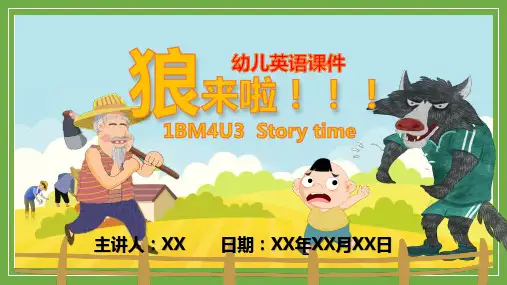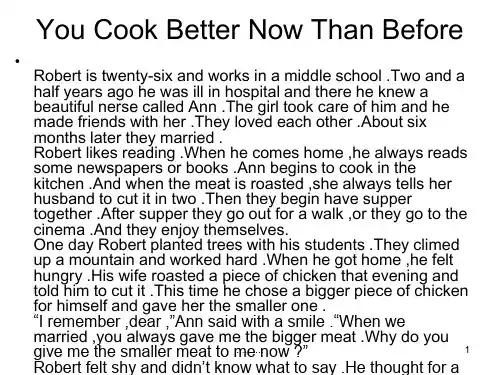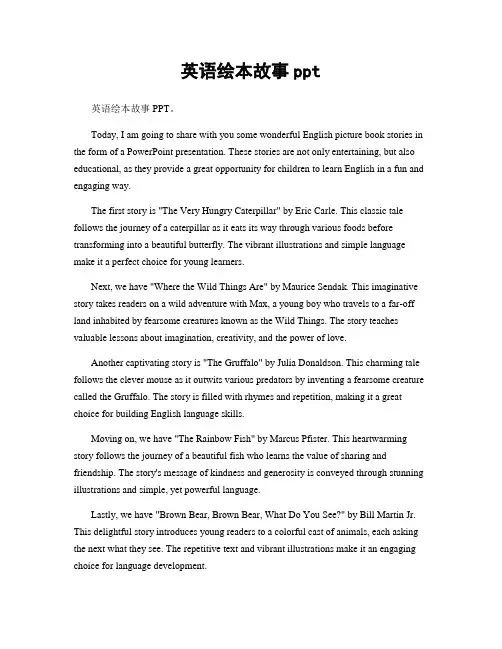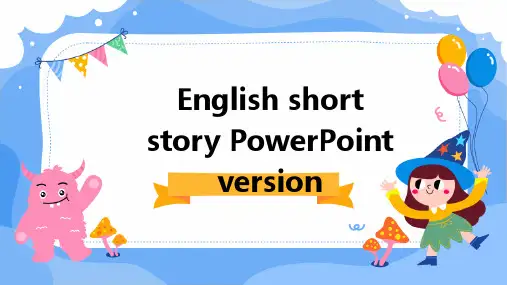最新小学英语故事教学.ppt
《英文绘本故事》课件

编辑:对翻译后的文字进行编辑,使其符合中文表达习惯,易于理解
校对:对翻译和编辑后的文字进行校对,确保没有错别字、语法错误等
排版:根据绘本故事的内容,对文字进行排版,使其与图片、插画等元素相协调,易于阅 读
绘本故事的图片选择和处理
选择图片:选 择与故事内容 相符的图片, 如人物、场景、 物品等
字体和字号:选择易于阅读的字体和字号,确保课件的易读性和美观性
PPT课件的文字和图片处理
文字处理:选择 合适的字体、字 号、颜色,确保 文字清晰易读
图片处理:选择 与主题相关的图 片,调整大小、 位置,确保图片 与文字协调
动画效果:添加 适当的动画效果 ,使课件更加生 动有趣
排版布局:合理 安排文字和图片 的位置,确保课 件整洁美观
方便快捷:可 以随时随地进 行学习和复习, 不受时间和地 点的限制
02
绘本故事的选择
选择绘本故事的标准和原则
内容丰富:故事内容丰富,能够吸引孩子的注意力
教育意义:故事具有教育意义,能够帮助孩子学习知识、 培养良好的行为习惯
插图精美:插图精美,能够吸引孩子的视觉注意力
语言简单:语言简单易懂,适合孩子阅读和理解
设计精美:PPT课件的视觉效果和设计风格都非常吸引人,能够激发学生 的学习兴趣
互动性强:PPT课件中包含了许多互动环节,能够提高学生的学习参与度 和学习效果
实用性强:PPT课件中的内容可以直接应用于课堂教学,对于教师来说是 非常有价值的教学资源
对未来英文绘本故事PPT课件的发展和展望
技术发展:利用 AR、VR等技术, 增强互动性和沉 浸感
PPT课件的演示和互动功能
演示功能:支持幻灯片播放、动画效果、音频视频播放等 互动功能:支持问答、投票、游戏等互动方式,增加观众参与度 辅助功能:支持笔记、标注、分享等功能,方便观众理解和分享 技术支持:支持多种设备、操作系统和浏览器,保证演示效果和稳定性
《寓言故事狼来了》PPT课件(小学英语 少儿)

Where's the _w__o__l_f_?
Ha!Ha! No wolves.
Judge ( ) You are a good boy!
( ) You are a bad boy!
You are a bad boy!
Say and act
A wolf! A wolf! Farmer, help, help! Where’s the wolf? Ha…ha. No wolves. You are a bad boy!
(不要撒谎)
主讲人:XX 日期:XX年XX月XX日
Oh, boy. I'm hot.NI'omwtIirgeod.toI wslaenetpt.o sleep.
wolf
wolves
Where's the wolf? Ha!Ha! No wolves.
Say and act
A wolf! A wolf! Farmer, help, help! Where’s the wolf? Ha…ha. No wolves.
主讲人:XX 日期:XX年XX月XX日
farmer
chant
I am a farmer. I have a farm. Look at my farm. Big and nice.
bt oy
Hello, boy. What do you see? I see ________.
I can help you.
A wolf! A wolf! Farmer, help, help! Don’t tell a lie. I can help you. I’m sorry. Don’t tell alie.
Tell a lie, Bad, bad, bad, Tell a lie, No,no,no
5篇英语小故事详细版.ppt

..........
2
A Clever Panda
• A little panda picks up a pumpkin and wants to take it home. But the pumpkin is too big. The panda can’t take it home. Suddenly she sees a bear riding a bike toward her. She watches the bike. “I know! I have a good idea.” she jumps and shouts happily, “I can roll a pumpkin. It’s like a wheel.” So she rolls the pumpkin to her home. When her mother sees the big pumpkin, she is surprised, “Oh, my God! How can you carry it home?” the little panda answers proudly, “I can’t lift it, but I can roll it.” Her mother smiled and says,“What a clever girl! Use you heard to do something,”
..........
4
Do not throw good things away
• A man was going to the house of some rich person. As
he went along the road, he saw a box of good apples at
英语小故事分享ppt课件

Love you, son.
As a young man, Al was a skilled1 artist, a potter with a wife and two fine sons. One night, his older son developed a severe stomachache. Thinking it was only some common intestinal2(肠的) disorder3, neither Al nor his wife took the condition very seriously . But the boy died suddenly that night.
Tears came to my eyes as I realized what I had been a fool to judge Al as a failure. He had not left any material possessions behind. But he had been a kind loving father, and left behind his best love.
在我18岁离Βιβλιοθήκη 家之前的日子里爸爸每天晚上都会来到我的房间在我睡前吻我然后和我说儿子我爱你
Back when I was a child, Before life removed all the innocence. My father would lift me high, And dance with my mother me then spin me around till I fell asleep. then up the stairs he would carry me, and I knew for sure I was loved. if I could get another chance, another walk, another dance with him. I'd play a song that would never ever end. how I love love love, to dance with my father again. when I and my mother would disagree to get my way I would run from her to him. He'd make me laugh just to comfort me, then finally make me do just what my mama said. later that night when I was asleep. He left a dollar under my sheet.
英语绘本故事ppt

英语绘本故事ppt英语绘本故事PPT。
Today, I am going to share with you some wonderful English picture book stories in the form of a PowerPoint presentation. These stories are not only entertaining, but also educational, as they provide a great opportunity for children to learn English in a fun and engaging way.The first story is "The Very Hungry Caterpillar" by Eric Carle. This classic tale follows the journey of a caterpillar as it eats its way through various foods before transforming into a beautiful butterfly. The vibrant illustrations and simple language make it a perfect choice for young learners.Next, we have "Where the Wild Things Are" by Maurice Sendak. This imaginative story takes readers on a wild adventure with Max, a young boy who travels to a far-off land inhabited by fearsome creatures known as the Wild Things. The story teaches valuable lessons about imagination, creativity, and the power of love.Another captivating story is "The Gruffalo" by Julia Donaldson. This charming tale follows the clever mouse as it outwits various predators by inventing a fearsome creature called the Gruffalo. The story is filled with rhymes and repetition, making it a great choice for building English language skills.Moving on, we have "The Rainbow Fish" by Marcus Pfister. This heartwarming story follows the journey of a beautiful fish who learns the value of sharing and friendship. The story's message of kindness and generosity is conveyed through stunning illustrations and simple, yet powerful language.Lastly, we have "Brown Bear, Brown Bear, What Do You See?" by Bill Martin Jr. This delightful story introduces young readers to a colorful cast of animals, each asking the next what they see. The repetitive text and vibrant illustrations make it an engaging choice for language development.In conclusion, these English picture book stories are not only entertaining, but also valuable tools for language learning. Through engaging characters, captivating plots, and beautiful illustrations, these stories provide an immersive and enjoyable way for children to improve their English skills. I hope that this presentation will inspire you to share these wonderful stories with the young learners in your life. Thank you for your attention.。
英语小故事ppt版

03
"Perambulate"
This word means to walk around, usually in a Leisurely or
Exploratory Maner It is used to describe the narrator's walk
around the town
Key Phrase Analysis
The characters in the story are commonly simplified and symbolized within groups of people in real life, such as the rich, the poor, the powerful, and the powerless
• Apply the principles to your actions: If there are any principles or messages in the story that you feel are relevant to your life, try to apply them to your actions and decisions For example, if the story emphasizes the importance of kindness and comparison, try to be more careful of showing these qualities in your daily interactions with others
"I was..."
This is a simple past tense of the verb "to be," indicating that the narrator was in a certain state or condition in the past
英语小故事ppt课件
Do not throw good things away; you may be glad to have them at some other time.
• A man was going to the house of some rich person. As he went along the road, he saw a box of good apples at the side of the road. He said, "I do not want to eat those apples; for the rich man will give me much food; he will give me very nice food to eat." Then he took the apples and threw them away into the dust.He went on and came to a river. The river had become very big; so he could not go over it. He waited for some time; then he said, "I cannot go to the rich man's house today, for I cannot get over the river." He began to go home. He had eaten no food that day. He began to want food. He came to the apples, and he was glad to take them out of the dust and eat them.
卡通英语绘本小故事小红帽ppt课件
Wolf:I can see you pretty face. Little Red Riding Hood:Oh! What a big hand. Wolf:I can hug you. Little Red Riding Hood: Look! What a big hands? Wolf: I can eat you! Little Red Riding Hood: Oh!No! No! Wolf: It’s delicious. I still sleep. I like sleeping.
Then,a hunter came. And he saw the Big Wolf was sleeping. Hunter: Where’s the wolf? Look! A door. The wolf is sleeping. Wolf: “ZZZ„ZZZ„” Hunter: What a big stomach! Grandma and Little Red Riding Hood are inside .I must be hurry. Look! Scissors, Cut, cut, cut. Little Red Riding Hood/Grandma:Thank you. Hunter:Grandma ,give me some needles and thread. Little Riding Hood ,Give me some stones. Little Red Riding Hood: One, two, three. Grandma: I'll thread it.
My English Story
——Little RБайду номын сангаасd Cap
最新2019年小学英语绘本《I Like Myself .》教学课件PPT
Listen to the story again and these questions.
(再听一遍故事并回答问题)
1.How many animals are there in the story? What are they ?
2.Is Baby Fox sad at the end (最后)of the story? Why or why not ?
It‘ s OK,a fox can’t hop like a rabbit.
I can’t like a rabbit .
Q:Which group is better 2
Read P2 quickly and answer the question on the small sheet . (看第二页并完成 小纸上的练习。)
Baby Fox sees ______ . He wants to ________ . But he __________. So _____________.
Look at the picture ,can you raise questions?
(看这些图片你能提出问题吗?)
Read P3 quickly aloud and answer the question .
Who does the Baby Fox see ?
Q :Who does the Baby Fox see ?
1. A bird . 2. A dog . 3. A rabbit .
Underline the key sentence. (划出重点句子)
(Baby Fox sees a rabbit hopping down the road.)
(大声朗读第三页并回答问题)
(完整word版)小学英语教学小故事
小学英语教学小故事小学生的荣誉感很强,好胜心更强,遇事总想比个高低,争个优先。
我抓住儿童心理的这一特征,课上,我充分利用图片,让他们游戏、表演、竞赛,在愉快的、有意义的情景中发现、归纳、创造。
复习食物类单词时,我借助图片让学生做游戏,巩固所学的语言知识。
我把学生分成A、B、C三组,A组代表fruit,B组代表food。
我先对A组说:“I like fruit very much,What’s your favourite fruit?”A组的一位学生说:“I like mangoes.Miss Xu.many I have a mango , please?”我就把带有mango的图片递给A组的这位同学。
以同样的方式将带有的食品的图片交给A、B二组,然后要求持图片的学生随意地站成一个圆圈,让C组做游戏。
我说:“Put the fruit on the desk,Put the food on the chair。
”C组评出他们中谁做得对,谁做错了,把自己的图片错放在别人的地方,对方就得到这张图片。
接下来叫A组学生说出fruit包括哪些,依次类推。
哪组说错单词,哪组就要对方图片,最后决出哪组的图片多,教师就奖励冠军队。
这样,不仅参加游戏的学生的热情高涨,就是在座位上的学生也积极参与学习过程。
--------------------------------------------------------让每个孩子都成为主角蔷薇在英语课堂上,教师机敏的教学机智应表现在对孩子主体的尊重,表现为对孩子的体验的理解等,而更多地则表现在让每一个学生都成为主角。
英语课上,每次积极举手的往往都是那些英语佼佼者,但是那些不敢举手的中等生或差生更需要关注。
记得一次,我上课提问,有一个学生平时成绩很一般,上课极少举手,可这一次我从他期待的眼神中,发现他很想回答,但又不敢举手。
我带着鼓励的语气叫了他,他的回答有些紧张,发音也有些错误。
- 1、下载文档前请自行甄别文档内容的完整性,平台不提供额外的编辑、内容补充、找答案等附加服务。
- 2、"仅部分预览"的文档,不可在线预览部分如存在完整性等问题,可反馈申请退款(可完整预览的文档不适用该条件!)。
- 3、如文档侵犯您的权益,请联系客服反馈,我们会尽快为您处理(人工客服工作时间:9:00-18:30)。
• 第二步:课内外语言知识和语言技能的巩固和运用—》 • 第三步:课外语言知识和语言技能的掌握—》
• 第四步:课内外语言测试
26 April 2020
16
语言能力培养的逻辑顺序
• 这种没有语言知识和技能巩固、运用和掌握过程的 教学和学习顺序,很难真正培养出学生的语言运用 能力,这也就不难解释为什么我们从初中,或者从 高一直接对学生进行类似于高考试题的训练的效果 不明显的原因。
2
讲座提纲
• 《英语课程标准》一级和二级能力目标要求分析 • 语言能力培养的逻辑顺序 • 关于英语阅读的基本理念与实践 • 小学英语课内外结合语篇教学建议 • 小学英语故事阅读教学案例分析
26 April 2020
3
《课标》二级目标要求
一级目标要求是按照: 听、做/说、唱/玩、演/读、写/视听 来分别进行要求的;
• 能在口头表达中做到发音清楚、重音正确、语调达意
• 能在教师的帮助下讲述小故事(Telling stories)
26 April 2020
6
读
• 能认读所学词语
• 能根据拼读规则 读出简单的单词能借助图片读懂简单的 故事或小短文,并养成按意群阅读 的习惯
• 能正确朗读所学故事或短文
26 April 2020
1. Reading has only one purpose, i.e. to get information.
2. Reading is a silent activity. Reading aloud does not help much with understanding.
3. Reading with a purpose is more effective than reading without a purpose.
小学英语故事教学
1
提纲
• 近年来小学英语教学的发展和问题 • 小学阶段《课标》要求解析及案例(首先给出关于语言知识和语
言技能的几个基本问题的提问) • 语言学习的逻辑发展顺序 • 英文故事片段欣赏 • 英语教材在发展学生语言能力方面的不足 • 教师指导下的学生课内外自主阅读的重要性和必要性
26 April 2020
4. When we read, our eyes are constantly moving from letter to letter, word to word and sentence to sentence.
5. Reading mainly is an individual activity.
6. We need to read and understand all the words in order
• be (66)
the (62)
• a/an (48+2) to (45)
• I (37)
you (33)
• of (27)
have (21)
• for (18)
it (15)
• on (14)
we (12)
• there (11)
about (10)
• schoo1 (10)
• 这15个单词是小学生都会使用的。
1、能正确地朗读课文; 2、能理解简短的书面指令,并根据要求进行学习活动; 3、能读懂简单故事和短文并抓住大意; 4、能初步使用简单的工具书; 5、除教材外,课外阅读量累计应达到4万词以上。
26 April 2020
10
为什么从刚开始就要求阅读故事?
• 语言能力培养的逻辑顺序 • 文学故事阅读与词汇、语法学习 • 文学故事阅读与阅读能力培养以及其他语言能力
7
写
• 能根据要求为图片、实物等写出简单的标题 或描述
• 能模仿范例写句子 • 能写出简单的问候语 • 写句子时能正确使用大小写字母和标点符号
26 April 2020
8
玩、演、视听
• 能按要求用英语做游戏 • 能在教师的帮助下表演小故事或童话剧
26 April 2020
9
《课标》三级目标要求
语言教学具有良好反拨作用的语言测试)。
26 April 2020
15
语言能力培养的逻辑顺序
• 如果各位老师同意这个逻辑顺序的话,那我们再来看看日常 教学的顺序:
• 日常的教学顺序是从第一步直接跨到第四步,也就是课堂教 学之后,学生课内外直接进入大量的试题训练和模拟类训练 中,省去了中间非常关键的两个步骤!
二级目标要求则是按照: 听/说/读/写/玩、演、视听 来分别进行要求的。
26 April 2020
4
听
• 能在图片、手势的帮助下,听懂语速较慢但
语调自然的话语或录音材料
• 能听懂简单的配图小故事(Story-telling)
• 能听懂常用 指令和要求并做出适当的 反应
26 April 2020
5
说
的培养
26 April 2020
11
英语能力培养的逻辑顺序案例分析
• 1998—2008高考全国卷书面表达范文所用词汇 (374词)
• 说明:本表收录1998-2008年高考英语全国卷书面表 达范文(视为满分作文)的全部用词。
• 括号内的数字为该词使用的次数。
26 April 2020
12
1998-2008全国卷高考书面表达范文最常用15个词
• 尤其是对中下等成绩的学生来说更是如此!
26 April 2020
17
关于英语阅读的基本理念与实践
• What is reading? • How do we read?
26 April 2020
18
26 April 2020
19
26 Apread?
• 下面我们来看看语言能力培养的逻辑顺序:
26 April 2020
14
语言能力培养的逻辑顺序
• 第一步:课堂上语言知识的学习和语言技能的训练—》 • 第二步:课、内外语言知识和语言技能的巩固和运用—》 • 第三步:课外语言知识和语言技能的掌握—》 • 第四步:课内外语言测试(真正好的语言测试是对语言学习和
26 April 2020
13
问题是:
• 为什么高中老师从高一到高三一直在训练学生的 写作,而且是从高一上学期开始就直接拿类似于 高考的写作模拟试卷来训练学生的写作能力,很 多学生却无法在高考中得到大部分写作分数?是 词汇量不够吗?是高考写作要求的思想性较强吗? 显然不是。通过上面的分析,显然不是的!
